These regions, named Maaz and Seitah, contain rocks formed about 2.6 billion years ago, when Mars had not yet completely lost its atmosphere and oceans
MOSCOW, July 12. /tass/. The Perseverance rover discovered sedimentary rock deposits with large reserves of aromatic organic matter at two different points on the territory of the Jezero crater, presumably resulting from the contact of water with various Martian volcanic minerals. This discovery indicates the presence of significant reserves of similar organic substances on Mars, scientists write in an article in the journal Nature.
 |
| The Jezero crater. |
| Source: © NASA/JPL-Caltech/University of Arizona/USGS |
"We found a large number of very different aromatic organic molecules in two different geological formations on the territory of the Jezero crater. Clusters of these molecules were adjacent or located inside sedimentary rocks that arose as a result of interactions between liquid water and volcanic rocks at the bottom of the crater. This indicates the existence of a much more complex organic geochemical cycle on ancient Mars than was commonly believed in the past," the researchers write.
This conclusion was reached by an international group of planetary scientists led by Kenneth Farley, scientific director of the Perseverance mission, during the analysis of data collected using the spectrometer of NASA's fifth Mars rover during the analysis of rocks in two different regions of the Jezero crater, where this device landed in February 2021. These regions, named Maaz and Seitah, contain rocks formed about 2.6 billion years ago, when Mars had not yet completely lost its atmosphere and oceans.
Planetary scientists have studied the composition of sedimentary rock deposits in these two formations using the Sherloc ultraviolet spectrometer, capable of detecting even the most imperceptible traces of organic matter inside different types of minerals. Measurements carried out by scientists indicated that traces of various aromatic organic compounds, including derivatives of phthalic acid, naphthalene, benzene compounds and similar molecules, were present in the sedimentary rocks of Maaz and Seitakh.
Many of these layers of organic matter, as noted by scientists, were found inside or in the vicinity of deposits of carbonates, gypsum and other minerals arising from the interactions of water and volcanic rocks. According to researchers, the presence of organic matter at two points on the territory of the Jezero crater speaks in favor of the existence on ancient Mars of processes that led to the constant formation of "bricks of life" in the waters of ancient reservoirs of the fourth planet of the Solar system.
The researchers hope that this hypothesis will be finally confirmed in the coming years, when the rock samples collected by Perseverance from the Maaz and Seitah formations will be transported to Earth as part of the MSR mission. The samples of Martian minerals delivered to her for the first time will allow planetary scientists to study the composition of ancient organic matter formed at the bottom of an extraterrestrial reservoir.
The Search for Martian Life
The first plans for the creation of the Perseverance rover were announced by NASA in December 2012. The fifth NASA rover, representing a close analogue of its predecessor, the Curiosity rover, was launched into space at the end of July 2020, in February 2021 it successfully landed on Mars. After that, Perseverance successfully launched the first aircraft, the Ingenuity helicopter, into the atmosphere of Mars and began exploring the planet, including searching for possible traces of life.
Now the Perseverance rover is not only studying the properties of deposits of Martian sedimentary rocks, but also collecting their samples in a special cabinet installed on its board. The stored minerals will be returned to Earth by a special joint mission of the European Space Agency and NASA called MSR, which will be sent to the Red Planet no earlier than 2026.
